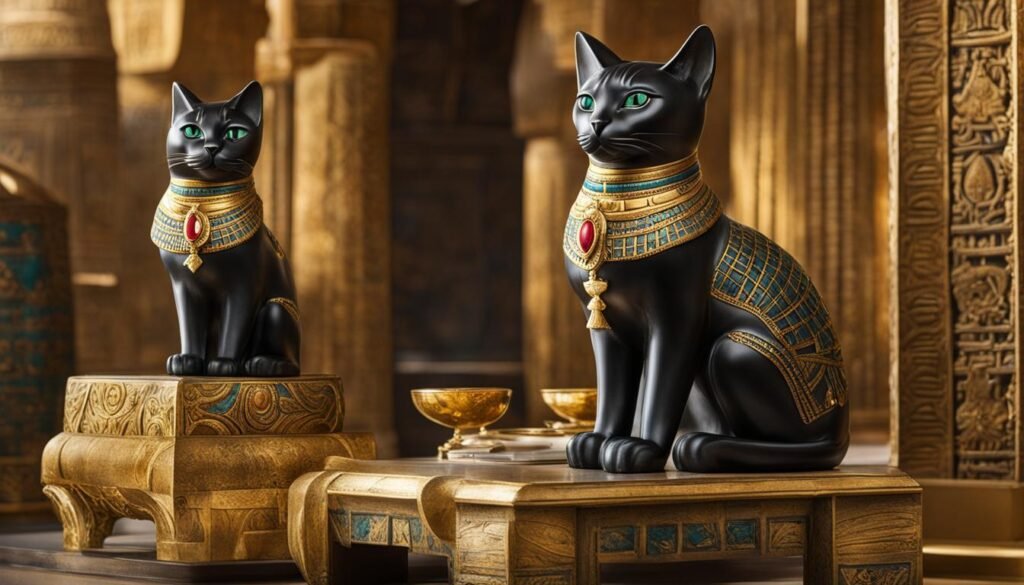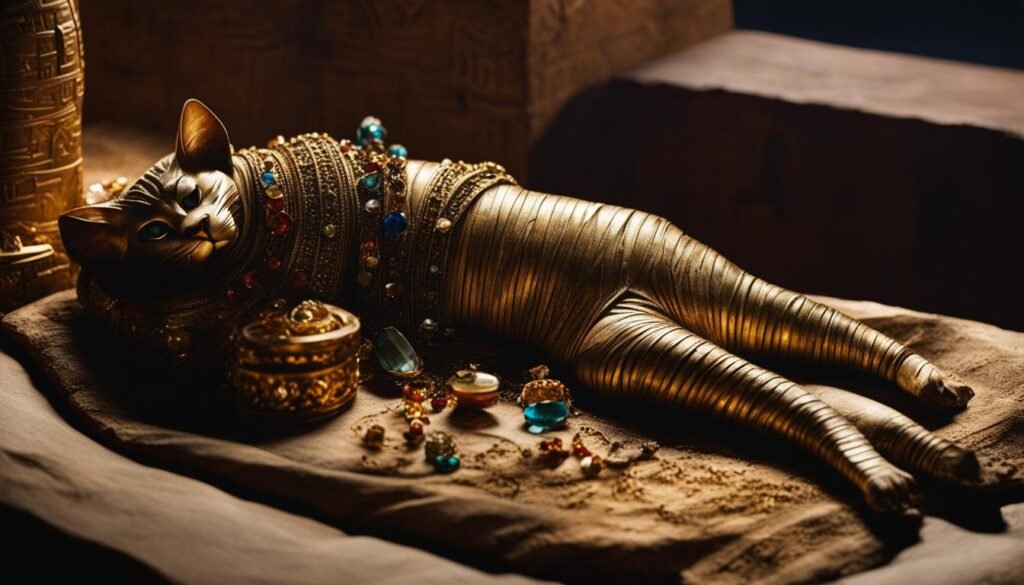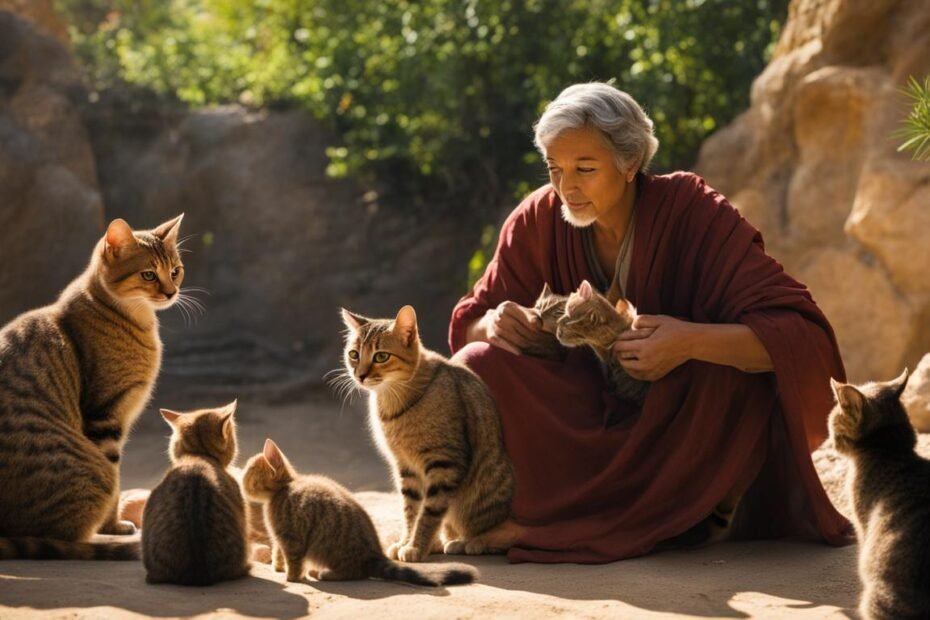Discover the intriguing history of domestic cats and their fascinating journey from wild creatures to beloved household companions. In this article, we’ll explore the evolution of domestic cats, the ancient civilizations that adored them, and the mysteries surrounding their domestication.
Key Takeaways:
- Early cat domestication can be traced back to the Near East around 10,000 to 12,000 years ago.
- Modern-day domestic cats share DNA similarities with the North African/Southwest Asian wildcat, Felis silvestris lybica.
- Ancient Egyptians worshipped and mummified cats, showcasing their deep adoration for these domesticated felines.
- Cat domestication spread across the globe, resulting in the diverse range of domestic cat breeds we see today.
- Cats are believed to have domesticated themselves to some extent, noticing the abundance of mice near human agricultural areas.
The Ancient Egyptians and their Adoration of Cats
The relationship between ancient Egyptians and cats went far beyond simply domestication. In Egyptian society, cats held a special place of reverence and were considered sacred animals. The goddess Bastet, often depicted with a lioness or domestic cat head, was the goddess of home, domesticity, and cats. The Egyptians believed that Bastet protected the home and brought good fortune to those who worshipped her. Cats were considered to be the embodiment of Bastet, and harming or killing a cat, even accidentally, was considered a serious crime punishable by death.
Egyptians’ adoration for cats can be seen in the artifacts and art that have survived throughout ancient history. In many tombs, mummified cats were buried alongside their human counterparts as beloved companions in the afterlife. These mummified cats were often adorned with intricate jewelry and buried in ornate cat-shaped coffins, showcasing the high regard in which they were held. The presence of these cat remains in tombs also reflects the belief that cats were protectors of the deceased’s soul and helped guide them to the afterlife.
“In the Egyptian pantheon, cats held a significant position, with Bastet as their revered guardian. The Egyptians’ deep affection for these domesticated felines is evident in their art and religious practices. Mummified cats and intricate cat-themed artifacts serve as a testament to the special place cats held in ancient Egyptian society.”
Not only were cats beloved companions and symbols of protection in ancient Egypt, but they also played a practical role in society. Egyptians valued cats for their natural ability to hunt and control vermin, particularly rodents that threatened grain stores. Their presence in Egyptian households helped mitigate the spread of disease and protect valuable food supplies. This practical aspect, combined with the spiritual significance attributed to cats, solidified their position as cherished members of Egyptian society.
The Importance of Egyptian Artifacts
Egyptian artifacts provide valuable insights into the role of cats in ancient Egyptian society. Images and sculptures of cats can be found throughout ancient Egypt, depicting them in various poses and contexts. These works of art not only showcase the Egyptians’ artistic skills but also highlight their deep affection for these domesticated felines. The inclusion of cats in religious and everyday scenes further emphasizes their importance in the daily lives of ancient Egyptians.
| Artifact | Description |
|---|---|
 |
An intricately carved statue of a cat, depicting the grace and elegance often associated with these animals. |
 |
A mummified cat carefully wrapped in linen bandages as a tribute to Bastet and a symbol of protection in the afterlife. |
| A hieroglyph depicting a cat, symbolizing the reverence and importance placed on these animals in ancient Egyptian culture. |
These artifacts not only serve as a visual representation of the Egyptians’ adoration of cats but also provide valuable historical evidence of the significance these animals held in their society. The intricate craftsmanship and attention to detail in these artifacts demonstrate the importance of cats in ancient Egypt and the profound impact they had on the lives and beliefs of the Egyptian people.
Cat Domestication Spreads across the Globe
Cat domestication did not remain confined to the Near East. It gradually spread to other parts of the world, carried by humans as they migrated and established new settlements. The European wildcat (Felis sylvestris) played an important role in the domestication process, contributing to the genetic makeup of modern domestic cats.
A study analyzing feline mitochondrial DNA and microsatellites discovered that domestic cats around the world share a significant genetic similarity with the North African/Southwest Asian wildcat, Felis sylvestris lybica. This suggests that the spread of domestication was not limited to a single lineage but involved the interbreeding of multiple wildcat populations.
The domestic cat’s expansion into Central Asia also took place over time. Cats arrived in the Orient around 2,000 years ago through trade routes connecting Greece, Rome, and the Far East. This enabled the exchange of domestic cats between Europe and Asia, resulting in distinct genetic differences among European and Oriental domestic cat breeds.
| Region | Years ago |
|---|---|
| Near East | 10,000-12,000 |
| Central Europe (Poland) | 4,200-2,300 |
| Orient (trade routes) | 2,000 |
Today, there are 71 recognized domestic cat breeds worldwide, each with its unique traits and characteristics. This remarkable diversity is a testament to the long and complex journey of cat domestication, spanning thousands of years and multiple continents.
Further research and DNA analysis continue to shed light on the fascinating history of early cat domestication, revealing the intricate relationships between humans and their feline companions throughout the ages.
The Mysteries of Cat Domestication
The process of cat domestication is a fascinating subject that has puzzled scientists and cat lovers alike. Through DNA analysis and research, we have gained valuable insights into the relationship between cats and humans and the evolutionary changes that have shaped our feline companions.
Genetic studies have revealed that cat domestication was likely influenced by agriculture. Ancient humans noticed the abundance of mice near their agricultural areas, and cats, with their natural hunting abilities, were welcomed as effective vermin controllers. Over time, cats began to tolerate human presence and form a mutually beneficial relationship. This self-domestication process resulted in unique genetic changes that set domestic cats apart from their wild counterparts.
“Cats have a long history of living closely with humans, and their domestication is a complex phenomenon,” says Dr. Julia Fischer, a leading expert in animal behavior and domestication. “Their ability to adapt to various environments and form social bonds with humans is a testament to their extraordinary nature.”
The Role of Breeders in Cat Domestication
In addition to self-domestication, breeders have played a significant role in shaping domestic cat breeds. Selective breeding techniques have allowed humans to refine specific physical and behavioral traits in cats, resulting in the diverse range of breeds we see today. From the elegant Siamese to the fluffy Maine Coon, each breed showcases unique characteristics that have been carefully cultivated over centuries.
| Breed | Origin | Distinctive Traits |
|---|---|---|
| Persian | Persia (modern-day Iran) | Long, silky coat; round face; gentle temperament |
| Bengal | United States | Spotted or marbled coat; athletic build; playful nature |
| Ragdoll | United States | Large, muscular body; docile personality; propensity to go limp when picked up |
While the mysteries of cat domestication continue to captivate researchers, our bond with these enigmatic creatures remains strong. As we delve deeper into the genetic origins of our feline companions, we gain a deeper appreciation for their remarkable journey from the wild to our cherished household pets.
Conclusion
Early cat domestication is a fascinating journey that began over 10,000 years ago in the Near East. The domestic cat we know today can be traced back to the North African/Southwest Asian wildcat, Felis sylvestris lybica. These wildcats coexisted with humans, helping control mouse populations in their grain stores.
Ancient civilizations, like the Egyptians, revered and valued domesticated cats. The goddess Bastet played a significant role in their adoration, symbolizing protection and domesticity. Egyptian artifacts and historical evidence showcase the deep affection Egyptians had for their feline companions.
Over time, cat domestication spread across the globe, resulting in the diverse range of domestic cat breeds we see today. Cats arrived in the Orient through trade routes between Greece, Rome, and the Far East. European and Oriental domestic cat breeds have distinct DNA differences, indicating centuries of independent breeding in Asia and Europe.
Understanding the secrets of early cat domestication and feline evolution is an ongoing endeavor. Through DNA analysis and further research, we continue to unveil the mysteries behind the incredible bond between cats and humans. From their humble beginnings in the wild to their cherished status as household companions, cats have left an indelible mark on our lives.
FAQ
When did cat domestication begin?
Cat domestication began around 10,000 to 12,000 years ago in the Near East.
What is the lineage of domestic cats?
Domestic cats originate from the North African/Southwest Asian wildcat, Felis sylvestris lybica.
Did ancient civilizations worship cats?
Yes, ancient Egyptians worshipped and valued domesticated cats, with the goddess Bastet being their protector.
How did cat domestication spread?
Cat domestication spread across the globe over time, reaching the Orient around 2,000 years ago through trade routes.
How many domestic cat breeds are there?
There are currently 71 recognized domestic cat breeds worldwide.
How did early humans tolerate wild cats?
Early humans tolerated wild cats for their vermin-hunting abilities and the control they provided over rodents in grain stores.
Did cats play a role in their own domestication?
Yes, cats noticed the abundance of mice near human agricultural areas and likely domesticated themselves to some extent.
What changes have domestic cats undergone?
Genetic studies have shown that domestic cats have undergone changes in certain genes related to cognition and behavior.
Have breeders influenced domestic cat traits?
Yes, breeders have selectively bred domestic cats for specific physical and behavioral traits.
Will further research reveal more about early cat domestication?
Yes, further DNA analysis and research will continue to unveil the secrets of early cat domestication and their journey from the wild to our cherished household companions.
